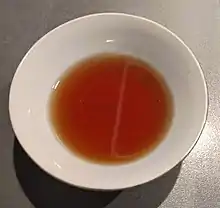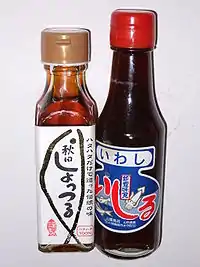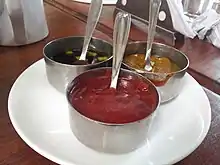Fish sauce
Fish sauce is a liquid condiment made from fish or krill that have been coated in salt and fermented for up to two years.[1][2]: 234 It is used as a staple seasoning in East Asian cuisine and Southeast Asian cuisine, particularly Myanmar, Cambodia, Laos, Philippines, Thailand, and Vietnam. Some garum-related fish sauces have been used in the West since the Roman times.
 | |
| Type | Condiment |
|---|---|
| Place of origin | Various places |
| Region or state | Southeast Asia and East Asia |
| Associated cuisine | Myanmar, Cambodia, Laos, Philippines, Thailand, and Vietnam |
| Main ingredients | Fish, salt |
| Part of a series on |
| Chinese cuisine |
|---|
 |
 |
| This article is part of the series |
| Japanese cuisine 日本料理 |
|---|
|
|
| Fish sauce | |||||||||||||||||
|---|---|---|---|---|---|---|---|---|---|---|---|---|---|---|---|---|---|
| Chinese name | |||||||||||||||||
| Traditional Chinese | 魚露 | ||||||||||||||||
| Simplified Chinese | 鱼露 | ||||||||||||||||
| |||||||||||||||||
| Alternative Chinese name | |||||||||||||||||
| Traditional Chinese | 蝦油 | ||||||||||||||||
| Simplified Chinese | 虾油 | ||||||||||||||||
| |||||||||||||||||
| Second alternative Chinese name | |||||||||||||||||
| Traditional Chinese | 魚水 | ||||||||||||||||
| Simplified Chinese | 鱼水 | ||||||||||||||||
| |||||||||||||||||
| Burmese name | |||||||||||||||||
| Burmese | ငါးငံပြာရည် (ngan bya yay) | ||||||||||||||||
| Vietnamese name | |||||||||||||||||
| Vietnamese alphabet | nước mắm | ||||||||||||||||
| Chữ Nôm | 渃𩻐 | ||||||||||||||||
| Thai name | |||||||||||||||||
| Thai | น้ำปลา | ||||||||||||||||
| RTGS | nam pla | ||||||||||||||||
| Korean name | |||||||||||||||||
| Hangul | 어장 | ||||||||||||||||
| Hanja | 魚醬 | ||||||||||||||||
| |||||||||||||||||
| Japanese name | |||||||||||||||||
| Kanji | 魚醤 | ||||||||||||||||
| Kana | ぎょしょう | ||||||||||||||||
| Kyūjitai | 魚醬 | ||||||||||||||||
| |||||||||||||||||
| Malay name | |||||||||||||||||
| Malay | sos ikan | ||||||||||||||||
| Indonesian name | |||||||||||||||||
| Indonesian | kecap ikan | ||||||||||||||||
| Filipino name | |||||||||||||||||
| Tagalog | patis | ||||||||||||||||
| Lao name | |||||||||||||||||
| Lao | ນ້ຳປາ (nam pā) | ||||||||||||||||
| Khmer name | |||||||||||||||||
| Khmer | ទឹកត្រី (tɨk trəy) | ||||||||||||||||
Due to its ability to add a savory umami flavor to dishes, it has been embraced globally by chefs and home cooks. The umami flavor in fish sauce is due to its glutamate content.[3]
Fish sauce is used as a seasoning during or after cooking, and as a base in dipping sauces. Soy sauce is regarded by some in the West as a vegetarian alternative to fish sauce though they are very different in flavor.[1]: 234
History
Asia
Sauces that included fermented fish parts with other ingredients such as meat and soy bean were recorded in China, 2300 years ago.[4] During the Zhou dynasty of ancient China, fish fermented with soybeans and salt was used as a condiment.[5][6] By the time of the Han dynasty, soy beans were fermented without the fish into soy paste and its by-product soy sauce,[7]: 346, 358–359 with fermented fish-based sauces developing separately into fish sauce.[8] A fish sauce, called kôechiap in Hokkien Chinese, might be the precursor of ketchup.[9][1]: 233
By 50-100 BC, demand for fish sauces and fish pastes in China had fallen drastically, with fermented bean products becoming a major trade commodity. Fish sauce, however, developed massive popularity in Southeast Asia. Food scholars traditionally divide East Asia into two distinct condiment regions, separated by a bean-fish divide: Southeast Asia, mainly using fermented fish (Vietnam, Thailand, Cambodia), and Northeast Asia, using mainly fermented beans (China, Korea, Japan). Fish sauce re-entered China in the 17th and 18th centuries, brought from Vietnam and Cambodia by Chinese traders up the coast of the southern provinces Guangdong and Fujian.[10]
Europe
Fish sauces were widely used in ancient Mediterranean cuisine. The earliest recorded production was between 4th–3rd century BC by the Ancient Greeks, who fermented scraps of fish called garos into one.[1]: 235 [11] It is believed to have been made with a lower salt content than modern fish sauces.[12]
The Romans made a similar condiment called either garum or liquamen.[1]: 235 According to Pliny the Elder, "garum consists of the guts of fish and other parts that would otherwise be considered refuse so that garum is really the liquor from putrefaction."[13] Garum was made in the Roman outposts of Spain almost exclusively from mackerel by salting the scrap fish innards, and then sun fermenting the flesh until it fell apart, usually for several months. The brown liquid would then be strained, bottled, and sold as a condiment. Remains of Roman fish salting facilities can still be seen, including in Algeciras in Spain and near Setúbal in Portugal. The process lasted until the 16th century when garum makers switched to anchovy and removed the innards.[1]: 235
Garum was ubiquitous in Classical Roman cooking. Mixed with wine it was known as oenogarum, or with vinegar, oxygarum, or mixed with honey, meligarum. Garum was one of the trade specialties in Hispania Baetica.[14] Garum was frequently maligned as smelling bad or rotten, being called, for example, "evil-smelling fish sauce"[15] and is said to be similar to modern colatura di alici, a fish sauce used in Neapolitan cuisine.
In English garum was formerly translated as fish pickle. The original Worcestershire sauce is a related product because it is fermented and contains anchovies.

 Ancient Roman garum factory in Portugal
Ancient Roman garum factory in Portugal Two amphoras for garum
Two amphoras for garum
Difference from oyster sauce
While fish sauce and oyster sauce are both briny and may have related histories, they are different products. Fish sauce is watery, clear, and salty, whereas oyster sauce is made by reducing oyster extracts and therefore sweeter with a hint of salt and not as strong an aroma as fish sauce.[16]
Ingredients and manufacture

Fish sauces historically have been prepared from different species of fish and shellfish, and from using the whole fish, or by using just fish blood or viscera. Most modern fish sauces contain only fish and salt, usually made from anchovy, shrimp, mackerel, or other strong-flavored, high oil fish. Some variants add herbs and spices. For modern fish sauces, fish or shellfish are mixed with salt at a concentration of 10% to 30%. It is then sealed in a closed container for up to two years.[1]: 234
Once the original draft has been made, some fish sauces will be produced through a re-extraction of the fish mass via boiling. To improve the visual appearance and add taste, second-pass fish sauces often have added caramel, molasses, or roasted rice.[1]: 234 They are thinner, and less costly. Some volume manufacturers of fish sauce will also water down a first-press to manufacture more products.
Fish sauce that has been only briefly fermented has a pronounced fishy taste. Extended fermentation reduces this and gives the product a nuttier, richer and more savory flavor.[17] An anonymous article, "Neuc-num", in Diderot and d'Alembert's 18th-century Encyclopédie, states: "It is said that Europeans become accustomed enough to this type of sauce".[18]
Regional variations
Southeast Asia
Southeast Asian fish sauce is often made from anchovies, salt, and water, and is intensely flavoured. Anchovies and salt are arranged in wooden barrels to ferment and are slowly pressed, yielding the salty, fishy liquid. The salt extracts the liquid via osmosis.
Southeast Asians generally use fish sauce as a cooking sauce. However, there is a sweet and sour version of this sauce which is used more commonly as a dipping sauce.
Cambodia
In Cambodia, fish sauce is called tik trei (Khmer: ទឹកត្រី, tœ̆k trei). Just like prahok, it is believed to date back to the pre-Angkorean era. Industrially fish sauce is produced by mixing trei aing keuy or anchovies with coarse salt and fermenting it in large wooden vats. Over the period of six to eight months, it is distilled five times, before being transferred into jars and sun-fermented for the final 2–3 months. The most famous fish sauce is produced in the Kampot Province. Food Production Company of Kampot produces a speciality fish sauce containing roe.[20] Fish sauce is mixed with sugar, lime juice, chili peppers and crushed roasted peanuts to create sweet fish sauce, which is the most popular dipping sauce in Cambodia.[21]
.jpg.webp) Cambodian sweet fish sauce mixed with chopped chili peppers and slices of garlic
Cambodian sweet fish sauce mixed with chopped chili peppers and slices of garlic
Laos
In Lao/Isan, it is called nam pa (Lao: ນ້ໍາປາ). A chunkier, more aromatic version known as padaek is also used.
Philippines
The Philippine fish sauce is known as patis. It is one of the most important ingredients in Filipino cuisine.[22] Patis is a by-product of bagoong production, which include bagoong isda (fermented fish) and bagoong alamang (fermented krill), as well as the rarer bagoong macabebe (fermented oysters) and bagoong sisi (fermented clams). The fish used are typically small like sardines, anchovies, ambassids, and the fry of larger fish. Unlike other fish sauce variants, the fermented solids are not discarded but are sold as separate products. The patis is skimmed from the upper layers of fermenting bagoong and is not pressed. As such, patis usually takes longer to produce than other types of fish sauce as it is reliant on the readiness of bagoong.[23][24][25]
Patis is nearly always cooked prior to consumption, even when used as an accent to salads or other raw dishes. Patis is also used as an ingredient in cooked dishes, including a rice porridge called arroz caldo, and as a condiment for fried fish. Patis is also used in place of table salt in meals to enhance the flavor of the food, where it can either be dashed from a dispensing bottle onto the food, or poured into a saucer and mixed with calamansi and labuyo chilis and used as a dipping sauce.[26][25][27][23]

 Commercial patis sold in the Philippines
Commercial patis sold in the Philippines%252C_Philippines.jpg.webp) Dipping sauce made from patis with siling labuyo peppers
Dipping sauce made from patis with siling labuyo peppers
Thailand
Fish sauce in Thailand is called nam pla (Thai: น้ำปลา). In Isan, it is called nam pa. Similar to the Laotian padaek is pla ra (Thai: ปลาร้า), also used in Thai cuisine. In Thailand, fish sauce is used both in cooking and also served at the table as a condiment, for instance in noodle soups. Nearly every Thai meal is served with phrik nam pla as a condiment: a mixture of fish sauce, lime juice, and chopped bird's eye chilies. Sliced garlic is often added to this sauce.
Historically, there were two types of fish sauce made in Thailand: that made with a fresh-water fish, pla soi, and sauce made from a salt-water fish, pla kratak. Either fish is fermented for at least eight months, three parts fish to two parts salt. The resulting mash is filtered. This yields the best fish sauce called the "base". The dregs are then mixed with water and salt and again fermented for three to four months. This yields a second-grade fish sauce, mostly used in cooking.[28]
In 2014, the US Food and Drug Administration (FDA) banned the import of Thai fish sauces due to a lack of information about tests for botulinum toxin. The toxin can cause death if more than 0.5 micrograms are consumed. The Thai Office of Food Safety and Quality then tested 48 brands of fish sauce to determine the content of botulinum toxin in the products. Of 48 brands tested, 28 were genuine fish sauces from 18 production sites in 12 provinces. Twenty samples from production sites in eight provinces were adulterated fish sauce. Tests showed that none were contaminated with botulinum toxin types A, B, E, and F and were free of Clostridium botulinum bacteria.[29] In 2018, rumours again surfaced concerning banned Thai fish sauce.[30]
 Nam pla phrik ("fish sauce with chili") is served with some Thai meals
Nam pla phrik ("fish sauce with chili") is served with some Thai meals Prepared fish sauces in Thailand
Prepared fish sauces in Thailand
Vietnam
The variety from Vietnam is called nước mắm.[31] There are two areas in Vietnam that are most famous for producing fish sauce: Phú Quốc and Phan Thiết.
Fish sauce has a 300 year history dating back to the Champa kingdom of the Cham people.[32] Phan Thiết can be identified with the birthplace of Vietnamese fish sauce. Before 1693, Phan Thiết was a territory of Champa. The Vietnamese occupied the area in 1693 and commercialized the fish sauce by keeping it in barrels and selling throughout the country. This business was popularized by Trần Gia Hòa who was born in 1872. There is a fish sauce museum in Phan Thiết. Popular brands in the US include Mega Chef, Red Boat, 3 Crabs, Golden Boy, and Hòn Phan Thiết.[33]
Vietnamese fish sauces are made with anchovies, mackerel, scabbard fish, and salt. High mercury concentration can be found in larger fish, especially in predator fish like scabbard fish. They do not have any additives like sugar, hydrolyzed protein, or preservatives.[34] Vietnamese prefer sauces without a strong smell, and transparent with a deep golden amber color. "First press" fish sauce, meaning the sauce is bottled from the first time the fermenting barrels are drained, also indicates quality. Lastly, when measuring the nitrogen level of fish sauces (N), most fish sauce on the market falls within the mid 20N range. Anything over 30N is considered high-grade, and 40N is optimal.[35]
Nước chấm is a Vietnamese prepared fish-based condiment (also referred to as a "sauce") that is savory, lightly sweet and salty tasting, and can be sour and spicy if lime and chili peppers are added. The main components are fish sauce, water, and sugar.
Mắm is made much like fish sauce, except that it is not fermented as long, and the fish is kept along with its liquid extract, not just the extract. Mắm can be used as a base condiment in dipping sauces with additional ingredients or used in soups or stir-fries.
In January 2016, the Institute of Food Technologists published a study asserting that using Vietnamese fish sauce as a substitute for sodium chloride (salt) in chicken broth, tomato sauce, and coconut curry reduced the amount of sodium chloride by 10 to 25 percent while still maintaining the perceived deliciousness, saltiness, and overall flavor intensity.[36] This idea is similar to the use of umami flavor enhancers such as MSG to increase flavor intensity and reduce sodium requirement.[37]
 Fishing boats in Phú Quốc, where the most prized fish sauce is made
Fishing boats in Phú Quốc, where the most prized fish sauce is made A fish sauce factory in Phú Quốc
A fish sauce factory in Phú Quốc A small bowl of nước chấm (literally meaning, dipping water)
A small bowl of nước chấm (literally meaning, dipping water)
China
In China, fish sauce is called yúlù (simplified Chinese: 鱼露; traditional Chinese: 魚露; pinyin: yúlù, literally "fish dew") and is native to the provinces of Guangdong and Fujian. In Chaoshan cuisine, fish sauce is made with Reeve's shad (Tenualosa reevesii), which is unsuitable for direct eating due to being fatty, bony, and odorous.[38]
Japan
In Japan, fish sauce is called gyoshō (魚醤); another name is uoshōyu (魚醤油). There are several variations used in regional cuisines. Ishiru in the Noto Peninsula is made from sardine and squid. Shottsuru, the best-known type of Japanese fish sauce and often used as a synonym for all gyoshō, is from Akita Prefecture and is mainly made from sailfin sandfish. Ikanago shoyu of Kagawa Prefecture is made from sand lance. They are used in nabemono, in salad dressings, and as a flavoring ingredient in ramen soups.
 Japanese Fish sauce, Shottsuru and Ishiru'
Japanese Fish sauce, Shottsuru and Ishiru'
Korea
In Korea, fish sauce is called eojang (어장).
Across the Korean Peninsula, aekjeot (액젓, literally "liquid jeotgal"), a type of fish sauce usually made from fermented anchovies or sand lances, is used as a crucial ingredient in many types of kimchi, both for taste and fermentation.[39][40]
In Jeju island, eoganjang (어간장), made of fermented godori (young chub mackerel) or horse mackerel, is used in place of soy sauce.

 Eo-ganjang of Jeju Island
Eo-ganjang of Jeju Island
Italy
Colatura di alici is an Italian fish sauce originating in the village of Cetara, Campania.
England
Worcestershire sauce contains fermented anchovies among other ingredients, which is common in the Anglosphere countries.
Nutrition contents
Common commercial brands of fish sauce generally contain about 50% to 60% of the FDA's daily recommended amount of sodium per tablespoon serving. Most commercial brands of reasonable quality contain one or two grams of protein per serving; however, higher-quality brands may have four grams of protein or more, while lower-quality brands may have less than one gram of protein per serving. Fish sauce has an insignificant amount of carbohydrates and fats. Vitamin B12, vitamin B-6, and magnesium are present in small amounts.
References
- McGee, Harold. On Food and Cooking: The Science and Lore of the Kitchen (Kindle ed.). Scribners.
- Abe, Kenji; Suzuki, Kenji; Hashimoto, Kanehisa (1979). "Utilization of Krill as a Fish Sauce Material". Nippon Suisan Gakkaishi. 45 (8): 1013–1017. doi:10.2331/suisan.45.1013.
- "Seashore Foraging & Fishing Study: From Poot-Poot to Fish Sauce to Umami to MSG". Archived from the original on 18 February 2009. Retrieved 6 September 2009.
{{cite web}}: CS1 maint: unfit URL (link) - Butler, Stephanie (20 July 2012). "Ketchup: A Saucy History". History. Retrieved 4 April 2017.
- "调料文化:酱油的由来". Big5.xinhuanet.com. Archived from the original on 30 January 2012. Retrieved 21 June 2018.
- zh:酱
- Hsing-Tsung, Huang (2000). Joseph Needham: Science and Civilisation in China, Vol.6, Part 5. Cambridge University Press. ISBN 0521652707.
- Kurlansky, Mark (2002). Salt: A World History. New York: Walker and Co. p. 20. ISBN 978-0-8027-1373-5.
- Gandhi, Lakshmi (3 December 2013). "Ketchup: The All-American Condiment That Comes From Asia". NPR. Retrieved 4 April 2017.
- Lim, Lisa (21 July 2017). "When China invented ketchup in 300BC, and how it morphed from a preserved fish sauce to sweet tomato gloop". South China Morning Post. Retrieved 25 November 2018.
- Farnworth, Edward R. (2003). Handbook of Fermented Functional Foods. Boca Raton, Florida: CRC Press. p. 22. ISBN 0849313724.
- Grainger, Sally. "Fish Sauce: An Ancient Condiment". Good Food SAT 1 OCT 2011. National Public Radio. Retrieved 26 October 2011.
- Natural History Pliny, the Elder. LoebClassics.com
- Wilkinson, Paul (2003). "Introduction". Pompeii: The Last Day. London: BBC. ISBN 9780563487708.
- Curtis, Robert I. (1 January 1983). "In Defense of Garum". The Classical Journal. 78 (3): 232–240. JSTOR 3297180.
- "How to Use Fish Sauce". The Spruce Eats. Retrieved 20 May 2021.
- Julalak Chuprom, Preeyanuch Bovornreungroj, Mehraj Ahmad, Duangporn Kantachote, Toshiki Enomoto, Statistical optimization for the improved production of an extracellular alkaline nuclease by halotolerant Allobacillus halotolerans MSP69: Scale-up approach and its potential as flavor enhancer of fish sauce, Biocatalysis and Agricultural Biotechnology, Volume 8, 2016, Pages 236-247
- Diderot, Denis (15 September 2012). "Fish Sauce". The Encyclopedia of Diderot and d'Alembert Collaborative Translation Project. Retrieved 1 April 2015.
- Mi Mi Khaing, Cook and Entertain the Burmese Way (Rangoon, 1975) p. 98
- Thaitawat, Nusara (2000). The Cuisine of Cambodia. Thailand: Nusara & Friends Co. Ltd. p. 31. ISBN 978-9-748-77885-3.
- "Sweet Fish Sauce". Cambodian Recipes. 6 July 2017. Retrieved 15 March 2020.
- "Patis / Fish Sauce". Market Manila. 14 July 2007. Retrieved 13 January 2019.
- "Filipino Icon: Bagoong". For Filipinos in Europe. 8 April 2014. Retrieved 13 January 2019.
- Van Veen, E.M. (1953). "Fish Preservation in Southeast Asia". In Mrak; Stewart, G.F. (eds.). Advances in Food Research. Vol. 4. Academic Press. p. 217. ISBN 9780080567495.
- "Patis - Filipino Fishy Goodness". Oyster Food and Culture. Archived from the original on 11 November 2020. Retrieved 13 January 2019.
- Olympia, Minerva (1992). "Fermented Fish Products in the Philippines". Applications of Biotechnology to Fermented Foods: Report of an Ad Hoc Panel of the Board on Science and Technology for International Development. National Academies Press.
- "Patis". TagalogLang. Retrieved 13 January 2019.
- Sukphisit, Suthon (25 November 2018). "Fish Tails". Bangkok Post. Retrieved 25 November 2018.
- "21 brands of Thai fish sauce free from botulinum toxin". Thai PBS. 6 February 2017. Archived from the original on 3 June 2019. Retrieved 25 November 2018.
- "FDA denies US ban on fish sauce from Thailand". The Nation. 25 October 2018. Archived from the original on 16 June 2019. Retrieved 25 November 2018.
- Robuchon, Joël (2009). Larousse Gastronomique (Updated ed.). London: Hamlyn. p. 714. ISBN 9780600620426.
- Ng, J. (2021, September 13). Fish Sauce Museum: 300-Year-Old Recipes & Champa Artifacts In Phan Thiết. The Smart Local. Retrieved May 25, 2022, from https://thesmartlocal.com/vietnam/fish-sauce-museum/
- Hildebrant, Kyle (17 February 2014). "Fish Sauce Taste Test, 13 Brands Compared – Our Daily Brine". Ourdailybrine.com. Retrieved 4 April 2017.
- Stanton, J. (2 May 2012). "What Are "Hydrolyzed Soy Protein" And "Hydrolyzed Wheat Protein," And Why Are They in Everything?". Gnolls.org. Retrieved 4 April 2017.
- "Everything you want to know about Phu Quoc Fish Sauce". Phuquocislandguide.com. Archived from the original on 25 August 2018. Retrieved 4 April 2017.
- Huynh, Hue Linh; Danhi, Robert; Yan, See Wan (27 November 2015). "Using Fish Sauce as a Substitute for Sodium Chloride in Culinary Sauces and Effects on Sensory Properties". Journal of Food Science. 81 (1): S150–S155. doi:10.1111/1750-3841.13171. PMID 26613570.
- Lubin, Gus (2 February 2017). "Everyone should cook with MSG, says food scientist". Business Insider. Retrieved 27 January 2019.
- Flavorful Origins, Season 1, Episode
- "REVIEW | Seoul Kimchi, Upper Brook Street | Confidentials Manchester". Manchester: Manchester Confidential. 1 November 2016. Archived from the original on 2 February 2017. Retrieved 4 April 2017.
- "Thousands prepare kimchi feast for Seoul's poor". Channel NewsAsia. Archived from the original on 8 November 2016. Retrieved 8 November 2016.
Further reading
- Cooks Illustrated (September/October 2015) "Fish Sauce Taste Test" Best Fish Sauces of 2021 | Cook's Illustrated
- Hastings (2015) Fish sauce a versatile ingredient that works in many cuisines.
- Hildebrant (2014) "Fish Sauce Taste Test, 13 Brands Compared" from Our Daily Brine
- Johnson (2015) "3 Reasons To Get A Little More Umami in your Diet". from US News health.
- Meewes, Veronica (2015) The Fish Sauce Cookbook published by Andrews McMeel ISBN, 9781449468699
- Murdoch (2004) Essential Seafood Cookbook Seafood sauces, pp. 128–143. Murdoch Books. ISBN 978-1-74045-412-4.
- Nguyen (2008) "How to Buy Fish Sauce: A Guide" Archived 8 September 2018 at the Wayback Machine from Viet World Kitchen
- Prichep, Deena (26 October 2013). "Fish Sauce: An Ancient Roman Condiment Rises Again". NPR. Retrieved 5 November 2013.
- Rosen (2013) "Can Fish Sauce Be Vietnam's Champagne?" from The Atlantic
External links
- Making Vietnamese prepared fish sauce dipping sauce (nước chấm) from HungryHuy.com
- Phu Quoc fish sauce guide Archived 25 August 2018 at the Wayback Machine from PhuQuocIslandGuide.com



